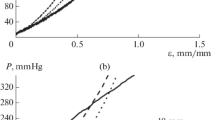Abstract
Peculiarities in structure and deformability of epicardial conduit coronary arteries are described. The thin wall of animal coronary artery contrasts the human coronary artery in which the remarkable wall thickness is due namely by the intima thickness. Deformation in length and diameter of conduit coronary arteries, due to the left and right ventricle volume increase, has been defined in non-beating canine heart. Ramus interventricularis anterior being firmly tethered to the myocardium undergoes about 3 times larger deformation than ramus circumflexus. In anaesthetized dogs a 30% increase in blood pressure, elicited by aortic constriction, induces an increase in diameter of coronary artery, in segment length, in blood flow and consequently in shear stress which represents a load for circumferentially running smooth muscle bundles, longitudinally running smooth muscle bundles, as well as for the endothelium. The above load lasting 4 h is already reflected by an increase in total RNA content and [14C] leucin incorporation in the left ventricle myocardium in the wall of ramus interventricularis anterior, not in ramus circumflexus. The findings fit completely with the different range of deformation of both the above coronary branches and indicates an increase in proteosynthesis not only in myocardium, but in ramus interventricularis anterior as well. An increase in ornithindecarboxylase activity in coronary wall leading to an increase in biogenic polyamines, is present in the case only, when blood pressure increase is induced by infusion of noradrenaline. (Mol Cell Biochem 147: 69–73, 1995)
Access this chapter
Tax calculation will be finalised at checkout
Purchases are for personal use only
Preview
Unable to display preview. Download preview PDF.
Similar content being viewed by others
References
Gerová M, Gero J, Barta E, Dole§el S, Smieško V, Levický V: Neurogenic and myogenic control of conduit coronary a.: a possible interference. Basic Res Cardiol 76: 503–507, 1981
Sims FH: A comparison of structural features of the walls of coronary arteries from 10 different species. Pathology 21: 115–124, 1989
Rabe D: Kalibermessung an den Herzkranzarterien and dem Sinus Coronarius. Basic Res Cardiol 68: 356–379, 1973
Purinja B, Kasjanov BA: Biomechanics of large conduit arteries in man (in Russian). Zinatne, Riga, 1984
Gerová M, Bárta E, Stolárik M, Gero J: Geometry of the conduit coronary artery in diastole is determined by the volume of the left and right ventricles. Basic Res Cardiol 84: 583–590, 1989
Gerová M, Bárta E, Stolárik M, Gero J: Heterogeneity in geometrical alterations of two main branches of left coronary artery induced by increase in left and right ventricle volume. Am J Physiol 262: H1049–H1053, 1992
Mann DL, Kent AL, Cooper G: Load regulation of the properties of adult feline cardiocytes: growth induction by cellular deformation. Circ Res 64: 1079–1090, 1989
Kent RL, Hoober JK, Cooper G: Load responsiveness of protein synthesis in adult mammalian myocardium: role of cardiac deformation linkèd to sodium influx. Circ Res 64: 74–85, 1989
Watson PA: Function follows form: generation of intracellular signals by cell deformation. Faseb J 5: 2013–2019, 1991
Gerová M, Stoev V, Kittová M, Koska J: Deformation of conduit coronary artery during afterload increase. Physiol Res 42: 9, 1993
Meyer WW, Walsh SZ, Lind J: Functional morphology of human arteries during fetal and postnatal development. In: C.J. Schwartz, N.T. Werthessen, S. Wolf (eds). Structure and Function of the Circulation. Plenum Press, New York, 1981, pp 95–380
Caney RG, Markov GG: Quantitative estimation of nucleic acids by spectrophotometric method (in Russian). Biochimija 25: 151–159, 1960
Nagai R, Low RB, Stirewalt WS, Alpert NR, Litten RZ: Efficiency and capacity of protein synthesis are increased in pressure overload cardiac hypertrophy. Am J Physiol 255: H325–H328, 1988
Johnson MD, Grognolo A, Kuhn CM, Schanberg SM: Hypertension and cardiovascular hypertrophy during chronic catecholamine infusion in rats. Life Sciences 33: 169–180, 1983
Majesky MW, Yang HYL, Juchau MR: Interaction of alpha and beta adrenergic stimulation on aortic ornithine decarboxylase activity. Life Sciences 36: 153–159, 1985
Thomson KE, Friberg P, Adams MA: Vasodilators inhibit acute alphaadrenergic receptor-induced trophic responses in the vasculature. Hypertension 20: 809–815, 1992
Bartolome J, Huguenard J, Slotkin TA: Role of ornithine decarboxylase in cardiac growth and hypertrophy. Sciences 210: 793–794, 1980
Zimmer. HG, Peffer H: Metabolic aspects of the development of experimental cardiac hypertrophy. Basic Res Cardiol 81 (S1): 127–137, 1986
Wiener J, Giacomelli F: Structural characterization of coronary arteries and myocardium in renal hypertensive hypertrophy. In: R.C. Tarazzi, J.B. Dunbar (eds). Perspectives in Cardiovascular Research. Raven Press, New York, 1983, 8, pp 60–72
Gerová M, Holécyová A, Kristek F, Fizel’ A, Fizel’ová: Remodelling and functional alterations of the rabbit coronary artery in volume overloaded heart. Cardiovasc Res 27: 2005–2010, 1993
Author information
Authors and Affiliations
Editor information
Editors and Affiliations
Rights and permissions
Copyright information
© 1995 Springer Science+Business Media Dordrecht
About this chapter
Cite this chapter
Gerová, M. et al. (1995). Biomechanical signals in the coronary artery triggering the metabolic processes during cardiac overload. In: Slezák, J., Ziegelhöffer, A. (eds) Cellular Interactions in Cardiac Pathophysiology. Developments in Molecular and Cellular Biochemistry, vol 14. Springer, Boston, MA. https://doi.org/10.1007/978-1-4615-2005-4_9
Download citation
DOI: https://doi.org/10.1007/978-1-4615-2005-4_9
Publisher Name: Springer, Boston, MA
Print ISBN: 978-1-4613-5828-2
Online ISBN: 978-1-4615-2005-4
eBook Packages: Springer Book Archive




